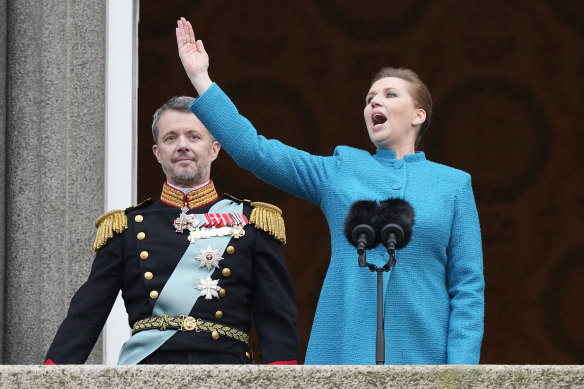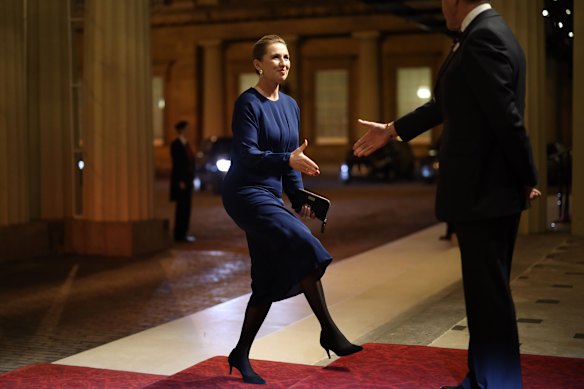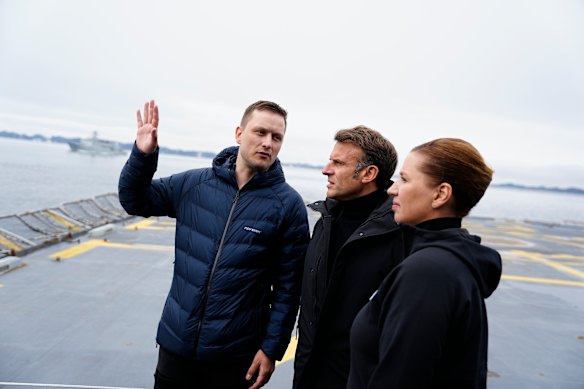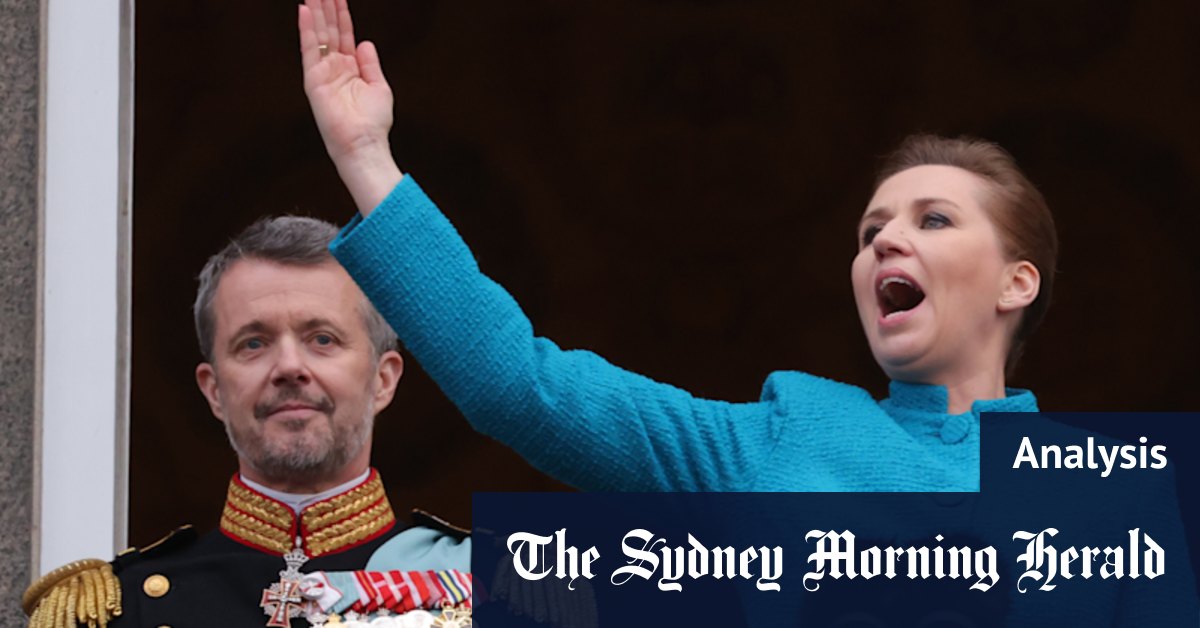She was a rising star on the left of the Social Democrats, the centre-left party she now leads. And she sparred with US President Donald Trump in his first term, when he sought to claim Greenland – and then did it again this year.
Now her plans make headlines because observers expect her to push the EU, as a bloc, towards embracing the hard-line policies that have worked for her in Denmark.

Mette Frederiksen proclaims new Danish King Frederik X from the balcony of Christiansborg Palace last year.Credit: AP
On defence, Frederiksen is urging Europe to spend heavily to ensure the EU can defend itself by 2030 – an immense task when Russia is making weapons faster than its enemies.
“Cutting our defence spending in the past 30 years was a huge mistake,” she said in Strasbourg. “Russia’s rearming means that they could, within two to five years, pose a credible military threat to Europe and NATO.”
Frederickson matches NATO Secretary-General Mark Rutte – a conservative from the Netherlands – in warning that the Russian threat is part of a broader danger from partners including Iran, North Korea and China.
Every word is a reminder that European concerns align with the Australian debate about China and whether the AUKUS submarine pact will produce results. Frederiksen met Prime Minister Anthony Albanese at the NATO summit in Lithuania in 2023.

Frederiksen arrives at Buckingham Palace to meet Queen Elizabeth in 2019.Credit: Getty Images
Denmark has moved more quickly and forcefully than its neighbours to close borders to asylum seekers and try to deport those who do not gain refugee status. Frederiksen sought an agreement with Rwanda to accept asylum seekers, but it has not led to transfers.
This can seem a startling shift for those who mainly see Denmark as a progressive Scandinavian state that has championed equal rights and a strong social safety net. Some Australians may find it hard to reconcile with the glamorous images of Queen Mary, the Tasmanian wife of King Frederik X.
‘It is beyond our comprehension how some people can come to our countries and get a sharein our freedom and our vast range of opportunities, and, indeed, decide to commit crimes’.
Open letter signed by Mette Frederiksen this yearMood turns against migration
However, there is significant discontent in Denmark about migration, turning the popular mood against the idea of a multicultural society where minarets can rise alongside Lutheran steeples.
A YouGov survey in February found that 41 per cent of voters in Denmark believed that migration was mostly bad for the country.
Voters in neighbouring countries have strong views, also, but the policies in Denmark have been tougher.
In 2018, for instance, the Social Democrat government unveiled a “ghetto package” of laws out of concern about neighbourhoods with large migrant populations. These laws sought to break up areas where most residents were “non-Western”, demolish their housing and move them elsewhere. The government has since moved away from using the “ghetto” label, and an adviser to the European Court of Justice has determined the laws are probably discriminatory.
Michelle Pace, a professor in global studies at Roskilde University in Denmark, says there has been a “paradigm shift” in Denmark towards a tougher migration policy and the results will be felt across the EU.

Frederiksen meets French President Emmanuel Macron (centre) and Greenlandic Prime Minister Jens-Frederik Nielsen in Greenland last month.Credit: AP
“Denmark’s migration policy, characterised by its increasingly strict approach and emphasis on repatriation, is a significant development,” says Pace, who is also an associate fellow at Chatham House in London and an associate member at Deakin University in Victoria.
“This shift, with its focus on stricter conditions for residency, family reunification, and a move away from integration towards repatriation, has gained domestic acceptance.”
Pace calls the Danish model a pioneer in harsh or restrictive migration policies, and it’s one clearly seen by several EU political leaders as an example to follow. In May, for instance, Italian Prime Minister Giorgia Meloni signed a letter with Frederiksen warning on migration and crime.
Loading
“It is beyond our comprehension how some people can come to our countries and get a share in our freedom and our vast range of opportunities, and, indeed, decide to commit crimes,” they wrote.
“Although this concerns only a minority of immigrants, it risks undermining the very foundation of our societies.”
Leaders from Austria, Belgium, Estonia, Latvia, Poland and other countries also signed the letter, highlighting concerns that are now mainstream.
Michala Clante Bendixen, the head of Refugees Welcome, a legal advice and advocacy group in Denmark, is scathing about Frederiksen because of the harsh attitude to outsiders from different cultures.
The Danish approach, she says, means a child can be born to migrant parents in Copenhagen and struggle to gain citizenship because of a complicated test.
“We only have very small left-wing parties in Denmark, and they don’t really have much power,” she told this masthead.
“It’s like the vast majority of members in parliament, no matter how the government changes, all agree on this very, very strict policy and the goal of zero asylum seekers.
“That is really shocking and very depressing, especially when it comes from the Social Democrats.”
Bendixen says some politicians have argued that it would be better to have 10 migrants from Britain than a single one from Somalia.
Loading
“I think that is shocking. How does that make you feel if you are a Somali Dane?” she said.
“How does it make you feel if you are a Muslim Dane, when people constantly talk about you as a problem and undermining Danish values? It’s racism in its clearest form.”
Whatever it is called, it is proving popular with voters in Denmark. The shift in community sentiment is clear. And if Frederiksen has her way, it will lead to change across Europe.
